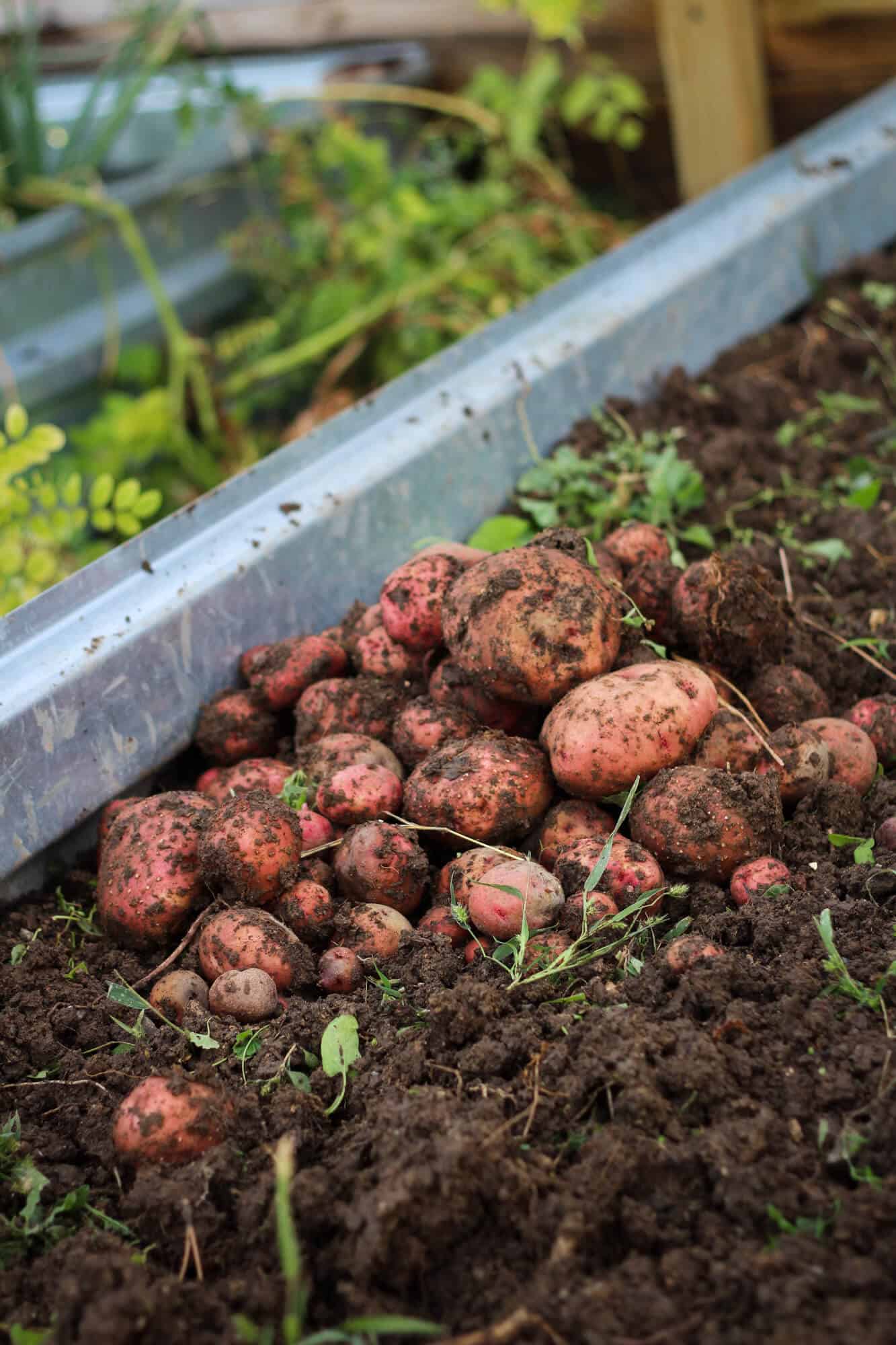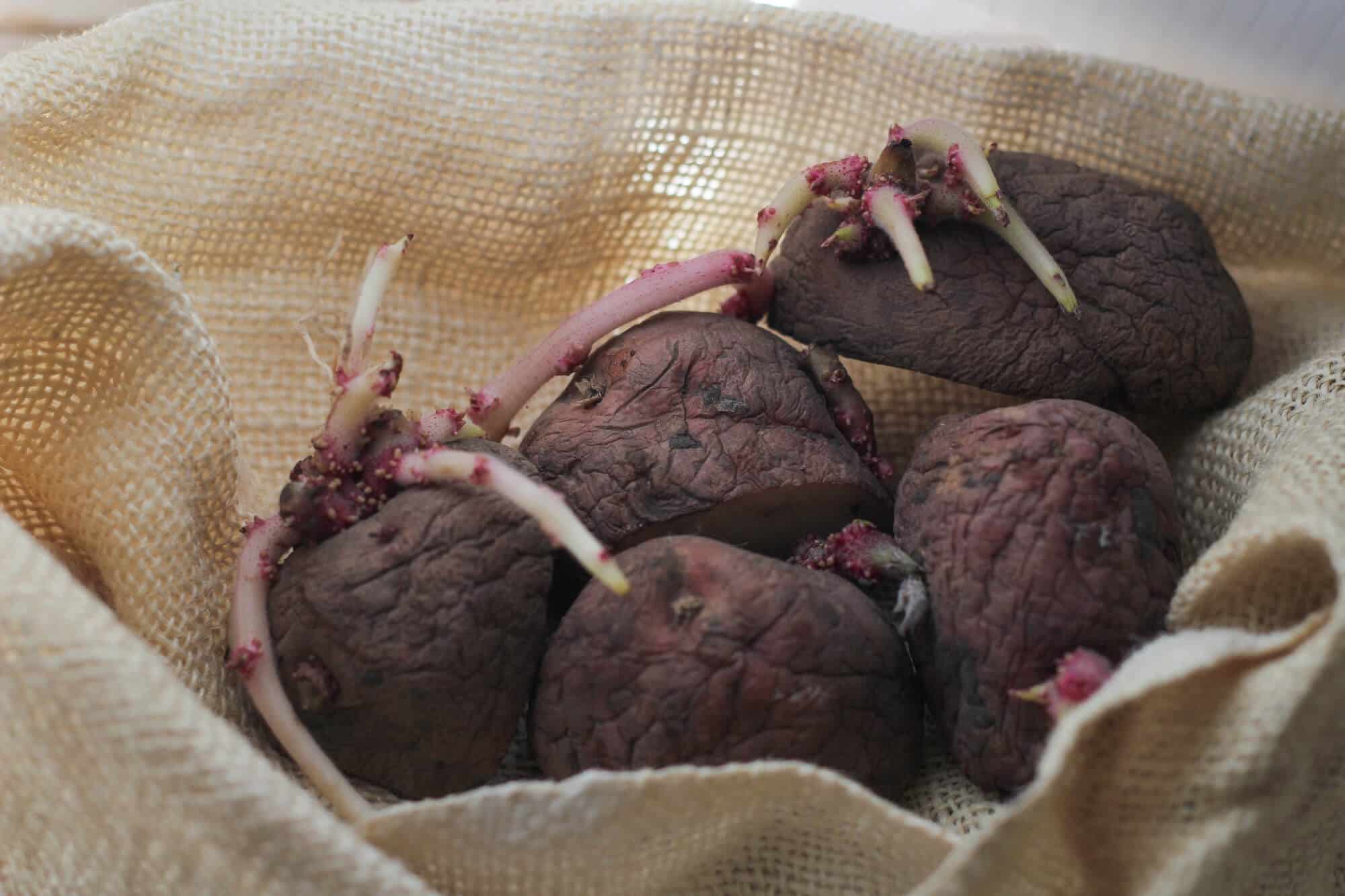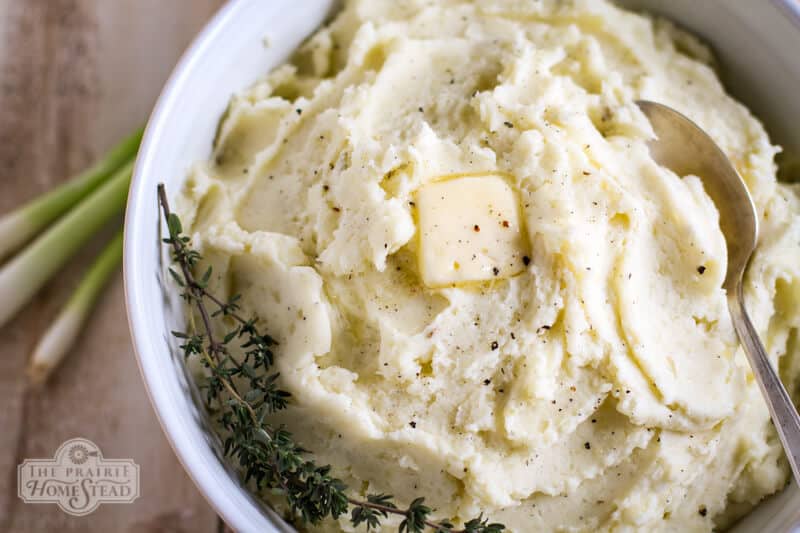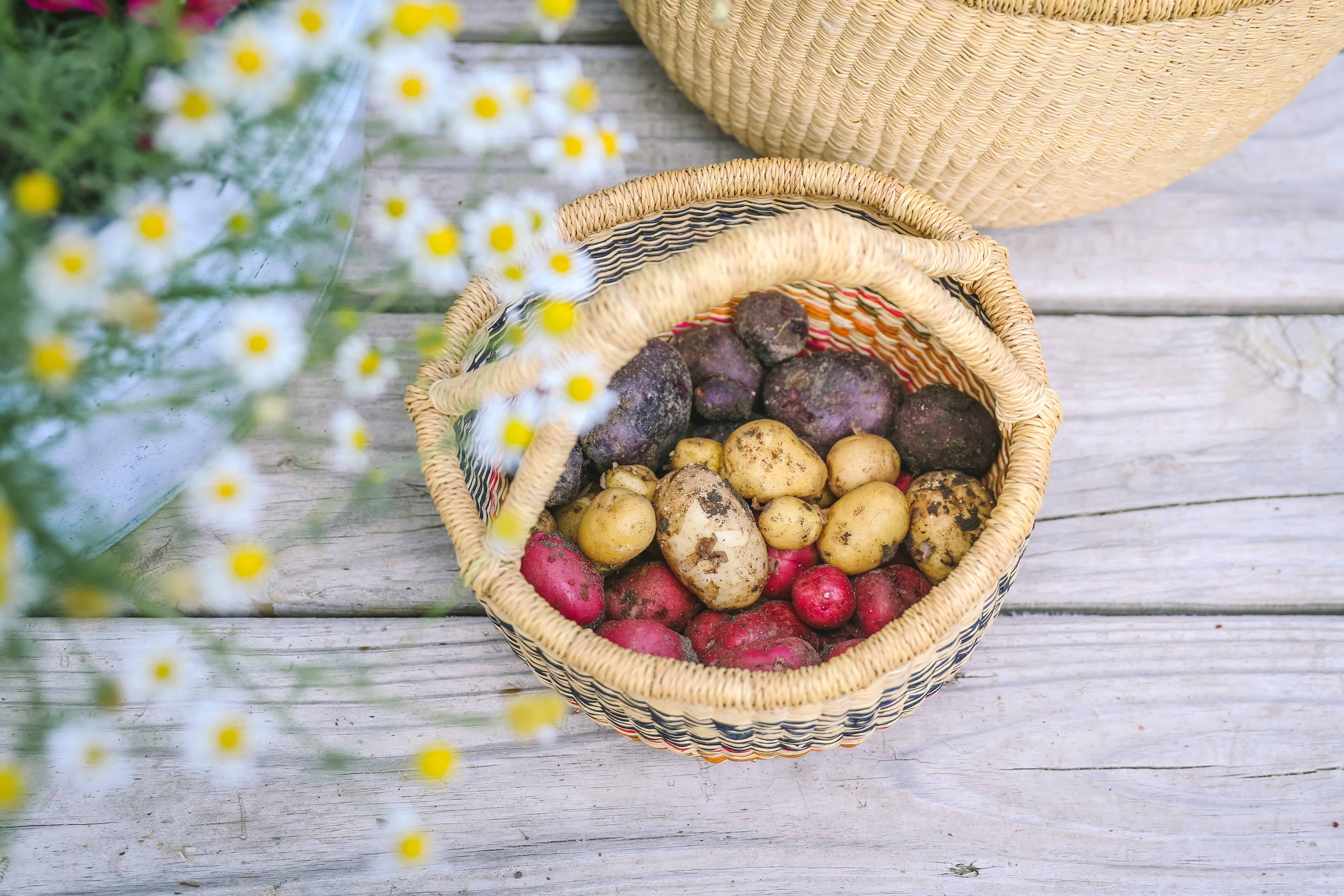Some people buy lottery tickets. I grow potatoes.
The thrill of not knowing what you’ll get is intoxicating, and I find myself giddy every time I head outside with my basket to harvest spuds for supper. It’s like winning a million dollars. Almost. 
But there’s something pretty awesome about any food that actually grows and thrives under ground. It feels like there’s a little bit of magic going on when you pull a few scallions or a handful of carrots, no? But there’s nothing quite like digging up a wagon full of potatoes. (Plus it’s pretty easy to learn how to grow potatoes, too)
Once your potato plants bloom, you can harvest tender (and super tasty) new potatoes anytime you’ve got that craving throughout the growing season (which is exactly what I did with the potatoes in the basket in the top photo), but at some point, you need to get the remaining potato crop out of the ground before it freezes (which happens pretty early here in Wyoming).
After you have a wagon full of spuds, you need to know how to keep them fresh. No one wants to go to grab a few potatoes in December, with dreams of creamy mashed potato goodness for dinner, to discover moldy, shriveled up spuds. (Been there, done that…)
If you store them well, your family will be loving baked potato soup or rustic potato sausage soup until it’s time to plant next year’s crop. Of course, there are a few things you’ll want to keep in mind for storing potatoes properly.

How to Dig Up Potatoes
How you harvest potatoes plays a big part in how long they’ll last in storage. Follow these simple tips to ensure your potato bounty lasts all winter.
Let ‘Em Die
Make sure you wait until the potato plants have completely died before digging up the crop. After the potato foliage turns brown and withers dies, I like to wait a few more weeks before digging up the potatoes. This helps the plants put their last energy into growing the tubers and also allows the skins to toughen up a bit.
Watch the Weather
Plan to dig up your crop of storing potatoes before the ground freezes (if that happens in your area), but it’s best to do this on a warm, dry day after a few days of no rain (if it rains, wait a few more days for the soil to dry before you begin your harvest).
This is easier said than done, especially with the unpredictable weather we have in Wyoming… You don’t even wanna know how many years I’ve been out frantically digging potatoes as a snow storm rolls in…
Get Your Nails Dirty.
You can dig up your potatoes with a garden fork or just get your hands dirty. Unless you’re more skilled with garden forks than I am, I recommend the dirt-under-your-fingernails method so you don’t risk jabbing any of the potatoes. (This works unless your ground is very hard– if that’s the case, use a shovel or fork to loosen chunks of soil, then use your hands to uncover the potatoes). If you accidentally impale or slice a potato during digging (it happens), separate it out and eat it within the next few days (perhaps try my favorite french fries recipe?), as damaged potatoes will not store well.
Resist the Urge to Clean Them.
I put the storing potatoes in my garden produce wagon and put them in the shade for an hour or so. As the tubers dry, the soil comes off easier. There’s really no need to brush them off perfectly– a little dry dirt doesn’t hurt anything. Just remember to never wash your storing potatoes—as that will drastically shorten their storage life.

Storing Potatoes
If you plan to store your potato harvest throughout the winter, you’ll need to cure them for about two weeks. Trust me, it’s worth the little extra effort. Curing will further toughen up their skin and it will help heal any small cuts and bruises. Curing is also an important step in order to extend the storage life of your potatoes.
How to Cure Potatoes
In order to cure your storing potatoes, spread them in a single layer on trays or cardboard boxes. If I was a perfectionist, I’d tell you to find a perfect location—a room where the temperatures are monitored closely between 55 and 65 degrees Fahrenheit and where the humidity levels register right at 85%. But sadly, not many of us have perfectly controlled environments. So do your best to hit those preferred temps and find a cool spot for them and cover the boxes or trays with dark towels, in order to keep the light out (that’s the most important part!) but still let the air circulate.
Be Picky
After a two-week curing process, check the potatoes and use any that seem bruised or shriveled for dinner that week.
Keep Them Cool
Move your storing potatoes to a dry, cool place for long-term storage. An unheated basement works great for storing potatoes, as well as some type of root cellar if you’re lucky enough to have one. I usually just keep mine in cardboard boxes (with the box flaps closed on to keep light out) in an unfinished room in our basement with concrete walls. It’s not perfect, but the potatoes usually last well into January or February that way.
But Don’t Let Them Freeze!
You may be able to store your potatoes in your garage. However it’s important that the potatoes don’t freeze, so a garage might not work for you, depending on your climate. Also keep in mind that temperatures higher than 40 degrees Fahrenheit can cause your tubers to sprout and shrivel more quickly.
Box ‘Em Up
Store your potatoes in a dark, well-ventilated container of your choice. I usually use cardboard boxes, but you can use whatever you have on hand so long as it keeps the potatoes protected from the light and allows for air circulation.
Ditch the Bad Ones. Often.
Check your storage potatoes often; if sprouts begin to form, knock the sprouts off with your hands. Every few weeks, I also check for any soft potatoes or any that show the beginning signs of rot. You may smell a musky smell, which tells you that there is a rotten potato in the bunch somewhere. Remove the bad potatoes to keep the others fresh.

More Tips to Properly Storing Potatoes
- Choose the best potato varieties for storage. For example, red potatoes do not keep as well as white or yellow potatoes. Thin-skinned potato varieties (like yellow potatoes) do not store as well as thick-skinned varieties (like russets). Also, late-maturing varieties usually store better than early-maturing types.
- Keep your stored potatoes away from apples, other fruit, or onions. Those foods release gases that cause potatoes to spoil or sprout prematurely.
- Recondition them before using them. Sometimes potatoes convert their starch to sugar while in storage, which gives them a sweet taste. But no worries– you can recondition your potatoes by taking them out of storage about a week before you plan on using them. Believe it or not, they’ll revert back to the right starch/sugar ratio. And, yes, this does mean you have to think about next week’s meals this week… not something that always happens in this house, but it’s sure nice when it does.
- Store your potatoes in the dark. When potatoes are exposed to light, they build up a chemical called solanin, which makes them turn green and bitter. If eaten in large amounts, solanin can cause illness, so trim off any green potato skin. If the green has penetrated into the potato, throw it away.
- Plant potatoes that have started to sprout. Any last potatoes that you find sprouted in your box in early spring are perfect for planting in your garden. Read more about growing and planting potatoes here.
If you follow these storage tips, you may find your potato harvest lasts until spring. Just think about how heavenly it will be to eat those tasty spuds all winter long!
Don’t mind me, I’m just sitting here thinking about all the amazing meals I’ll make all winter long with those properly stored potatoes that are piled up in my wheelbarrow right now in the shade.
What are YOUR best tips for storing potatoes throughout winter?
More Storage and Preserving Tips
- Everything You Need to Know for Canning Success
- How to Braid Garlic
- How to Braid Onions
- 13 Root Cellar Alternatives
- 40+ Ways to Preserve Tomatoes

The post Digging Up and Storing Potatoes for Winter appeared first on The Prairie Homestead.
Via Gardening http://www.rssmix.com/
No comments:
Post a Comment